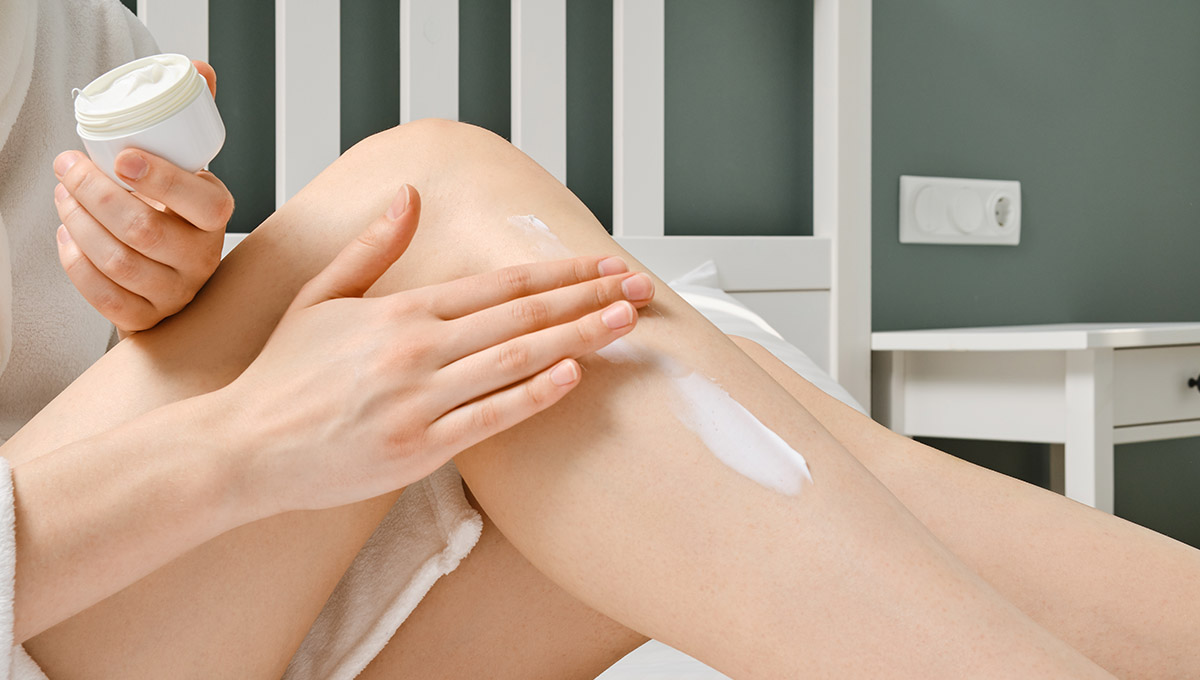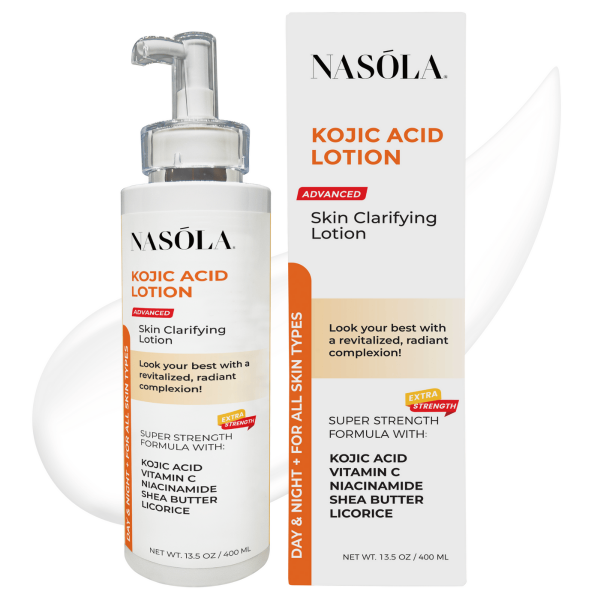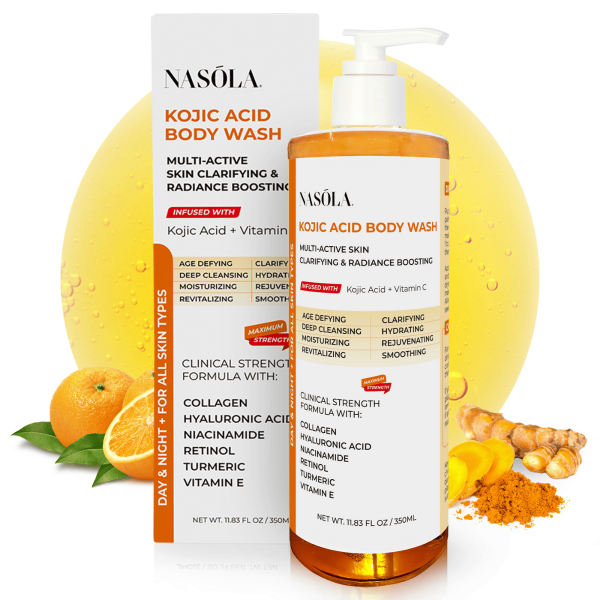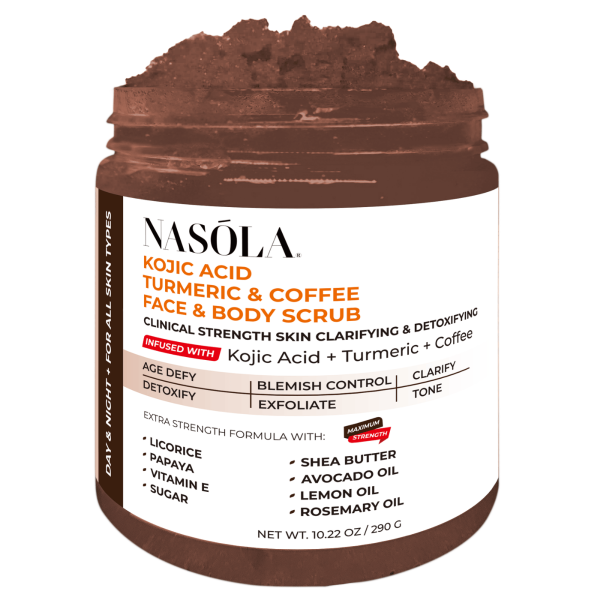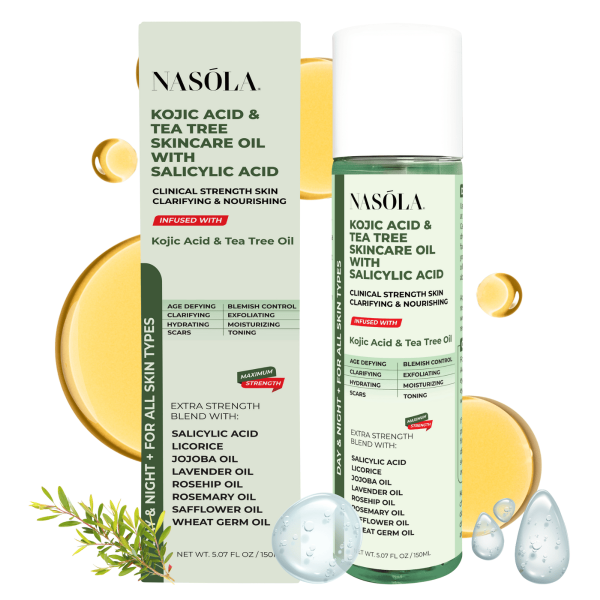If you’ve ever looked at your legs and thought, “Why are there these random dark spots here??” — you’re not alone. Hyperpigmentation on legs can be frustrating, especially if you’re dealing with brown patches that just won’t budge… no matter how much lotion you slather on.
This skin concern affects people of all complexions, but it’s more visible — and often more stubborn — on those with deep, rich, or Black skin tones.
The causes?
Oh, there are several: inflammation from shaving, bug bites that left scars, diabetes, or just way too much time under the sun without sunscreen.
Ready for the good part? You CAN treat it.
There are effective routines, science-backed ingredients, and products that are actually made to remove dark spots and balance your skin tone — without the harsh chemical leftovers.
We’re going to walk you through smart, proven options using skin-loving ingredients and standout formulas, like the Nasola Kojic Acid Body Wash and the Nasola Turmeric Scrub.
So… let’s clear things up.
Understanding Brown Hyperpigmentation on Legs
Brown hyperpigmentation on legs is one of those things that seems to linger longer than it should. It’s usually the result of excess melanin production in response to injury, irritation, or underlying conditions like diabetes.
For those with Black or richly melanated skin, it’s especially visible and often worsened by shaving or using harsh chemical cremes.
This type of discoloration typically shows up on the lower legs, behind the knees, or even on the arms. It’s not dangerous, technically — but emotionally? It can make you feel self-conscious and stuck in long pants, even in summer.
Let’s unpack some of the usual suspects behind this issue.
Causes of Brown Hyperpigmentation
Brown hyperpigmentation can be sneaky. One minute it’s a tiny bump or bug bite. The next? A dark patch that’s locked in place. Here are some of the biggest culprits:
- Post-inflammatory hyperpigmentation (PIH): From shaving bumps, minor cuts, folliculitis, or eczema flares.
- Exposure to sun: Especially when you skip sunscreen on your legs — yes, even on darker skin.
- Underlying conditions: Diabetes, for instance, increases the likelihood of discoloration on the legs.
- Harsh chemical products or cremes: These can cause burns or worsen uneven tone.
Understanding the causes is the first step in choosing the best treatment for your skin.
Nasola Kojic Acid Body Wash
Ready to treat brown hyperpigmentation on legs gently but effectively?
Nasola Kojic Acid Body Wash is formulated to help fade dark patches and even out skin tone—especially helpful on the lower limbs where discoloration persists.
Packed with kojic acid (which helps to block melanin production), this body wash provides a strong yet non-irritating treatment that’s ideal for daily use.
It’s perfect for anyone who shaves frequently or is battling PIH from old scars. Use it consistently, and you’ll notice smoother, brighter skin without the drying effect of typical chemical-based washes.
How to Get Rid of Hyperpigmentation on Legs
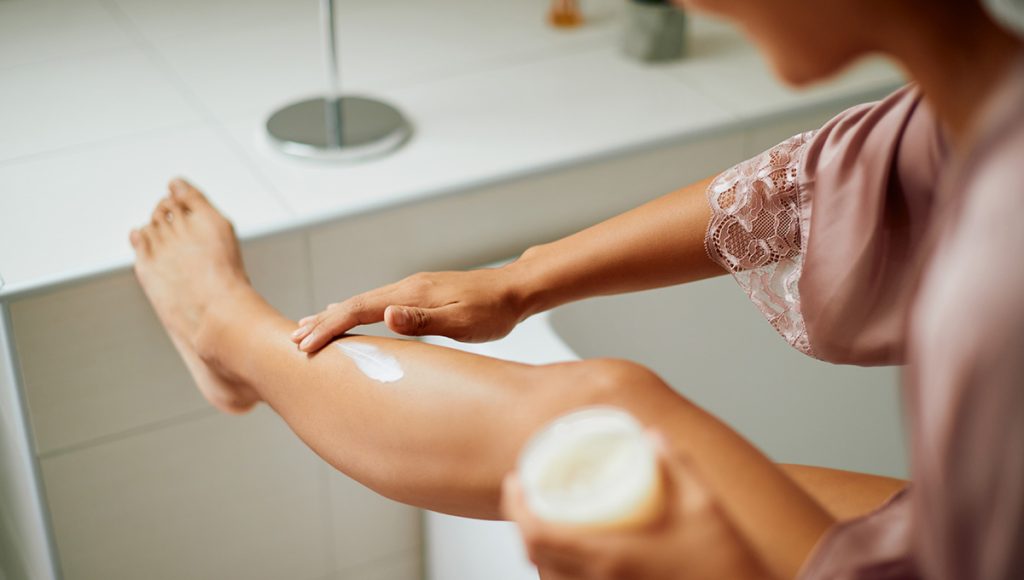
So, how to get rid of hyperpigmentation on legs? The answer lies in a routine — not a miracle. (Sorry, it won’t fade overnight… no matter how much you wish it would.) The key is a smart, layered approach combining exfoliation, targeted treatments, and hydration.
Natural brighteners like turmeric, kojic acid, and coffee work wonders — especially when paired with chemical exfoliants like salicylic acid or nourishing oils.
Let’s break down the pieces of a winning routine.
Exfoliation with Safe Ingredients
Exfoliation is a game-changer if you’re trying to remove hyperpigmentation scars on legs.
But — big but — not all scrubs are created equal. If you’re using harsh sugar scrubs or unknown chemical mixtures, you could be worsening your skin trauma.
Instead, opt for ingredients known to treat, not irritate:
- Turmeric: Brightens the skin and helps even tone.
- Kojic Acid: Reduces melanin production.
- Coffee: Gently buffs away dead skin and improves circulation.
- Oils: Help soothe, replenish, and lock in moisture.
This combo helps fade scars and restore vibrancy with consistent use.
Nasola Kojic Acid Turmeric Coffee Scrub
The Nasola Kojic Acid Turmeric Coffee Face & Body Scrub is not just any exfoliator — it’s a three-in-one superstar.
With turmeric for brightness, kojic acid for depigmenting, and coffee for smoothing skin texture, this scrub helps remove dark, dull skin cells from your legs, arms, or wherever pigment lingers. And yes, it smells divine while doing it.
Use it 2–3 times a week before applying your treatments or lotion for best results. Your skin will thank you for the glow-up!
Targeting Hyperpigmentation Spots on Legs
Some pigmented areas are more stubborn than others — you know, those little hyperpigmentation spots on legs that seem to laugh in the face of scrubs and washes.
For these, creams and lotions infused with brightening agents and healing ingredients offer the best results.
Here’s how to break it down further.
Ingredients Spotlight: Lotion-Infused Kojic Acid
Lotions don’t just moisturize — when they include ingredients like kojic acid, they do double-duty. Kojic acid works by interrupting melanin synthesis in the skin, making it ideal for treating dark patches left behind by old wounds, bug bites, or shaving irritation.
Look for formulas that also include hydrators or anti-inflammatory oils to prevent further trauma during treatment. A good skincare lotion for pigmentation makes all the difference.
Nasola Kojic Acid Lotion
Enter the Nasola Kojic Acid Lotion — a silky moisturizer infused with kojic acid that doesn’t just hydrate but also helps treat dark patches head-on.
Glide it on daily after bathing. You’ll notice how your skin starts to feel balanced — less tight, less ashy, and slowly, less marked by pigmentation.
Want the best results? Combine it with the body wash and scrub for a complete leg-focused routine.
Before and After Hyperpigmentation on Legs: What to Expect

We all love a good before and after transformation. But when it comes to before and after hyperpigmentation on legs, results vary — especially on Black or deeply pigmented skin where scars can run deep.
Consistency, patience, and sun protection are your magic trio.
Lifestyle and Care Routines Matter
Let’s not pretend it’s just about products.
Your daily habits can either hinder or speed up healing. Be honest with yourself about what your skin needs, then build a care ritual around it. Here’s what helps:
- Hydration: Water, fruits, and nutrient-packed meals help support internal healing.
- Sunscreen: Yes… even on your legs. Every day. Hyperpigmented skin darkens faster under UV rays.
- Gentle shaving: Always use protective shaving gel or oil to avoid razor bumps.
- Don’t pick or scratch: Let scabs heal naturally to avoid more brown marks.
Track progress with photos every 2 weeks to keep tabs on your results.
Nasola Kojic Acid Tea Tree Bio-Oil with Salicylic Acid
The Nasola Kojic Acid Tea Tree Skincare Bio-Oil with Salicylic Acid is your go-to for deep repair.
Salicylic acid gently peels away pigmented layers over time, while tea tree oil calms any inflamed follicles or bumps. Add kojic acid, and you’ve got a powerhouse to treat both scars and inflammation.
Use it nightly or after exfoliating to seal in healing ingredients and give troubled spots the attention they need.
Ingredient Spotlight: Kojic Acid
Okay, can we hype up kojic acid for a second?
This ingredient — derived from Japanese sake brewing — is what powers nearly every Nasola product. It targets hyperpigmented skin by stopping tyrosinase, the enzyme responsible for melanin production.
Here’s why it’s hype-worthy:
- Reduces melanin rapidly but gently.
- Safe for deeper skin tones and Black skin.
- Pairs well with exfoliators and moisturizing agents.
- Provides noticeable results in as little as 4 weeks.
If you’re looking for a natural, effective treatment for dark areas on the legs or arms — kojic acid is one of the best options out there.
Conclusion
Hyperpigmentation on legs doesn’t have to win. Whether you’re dealing with post-inflammatory scars, sun exposure marks, or discoloration from diabetes, there are several gentle but powerful ways to treat and restore your skin.
The right products? They matter. Build your routine with standouts like Nasola Kojic Acid Body Wash, Turmeric Coffee Scrub, Kojic Acid Lotion, and Bio-Oil with Tea Tree. Moisturize, exfoliate, and protect — that’s the formula.
Time, patience, and your effort will write the after-photo story you’re dreaming of.
Your skin deserves this care.
Now go treat your legs like the glowing spotlight zones they are!
Frequently Asked Questions (FAQs)
Several causes lead to leg hyperpigmentation: post-inflammatory responses (from shaving, bug bites, or eczema), sun exposure, diabetes, and injuries. These stimulate melanin production in injured areas, leaving behind brown or dark marks that are stubborn to fade.
For small hyperpigmentation spots, consider products like the Nasola Kojic Acid Lotion — it hydrates while fading discoloration. Pair it with the Bio-Oil for added scar repair, especially if the spot was caused by irritation or inflammation.
Yes. Products like Nasola Kojic Acid Body Wash and Lotion are safe for daily use. Consistency is key, but monitor for dryness or irritation. Always apply sunscreen if your legs will be exposed.
– For a full recovery routine:
– Daily: Kojic Acid Body Wash
– 2–3x Week: Turmeric Coffee Scrub
– Daily: Kojic Acid Lotion
– Nightly or After Bath: Bio-Oil with Salicylic Acid
With daily use of effective products (like those from Nasola), you can see visible improvements in 4 to 12 weeks. For darker skin tones or severe cases, it might take longer, but steady progress happens with consistency.
Absolutely. The ingredients in all Nasola products are safe for full-body use, including arms, inner thighs, and underarms. They’re especially ideal for Black or deeply pigmented skin types.
Unregulated cremes can worsen discoloration, cause burns, or damage your skin barrier. Always choose formulations with ingredients like kojic acid, turmeric, and salicylic acid, which Nasola uses responsibly.
Diabetes can reduce circulation and increase inflammation, making the skin more prone to dark patches — particularly on the lower legs. Nasola’s kojic-infused products can help even out tone safely.
Dark spots stem from excess melanin (hyperpigmentation), while scars involve deeper skin tissue damage. But many scars ALSO darken, so products like Nasola’s Bio-Oil with salicylic acid work on both.
Track progress with photos every 2 weeks, under the same light. You should begin to notice smoother texture, less visible spots, and brighter tone — especially with layered use of body wash, scrub, lotion, and Bio-Oil.

